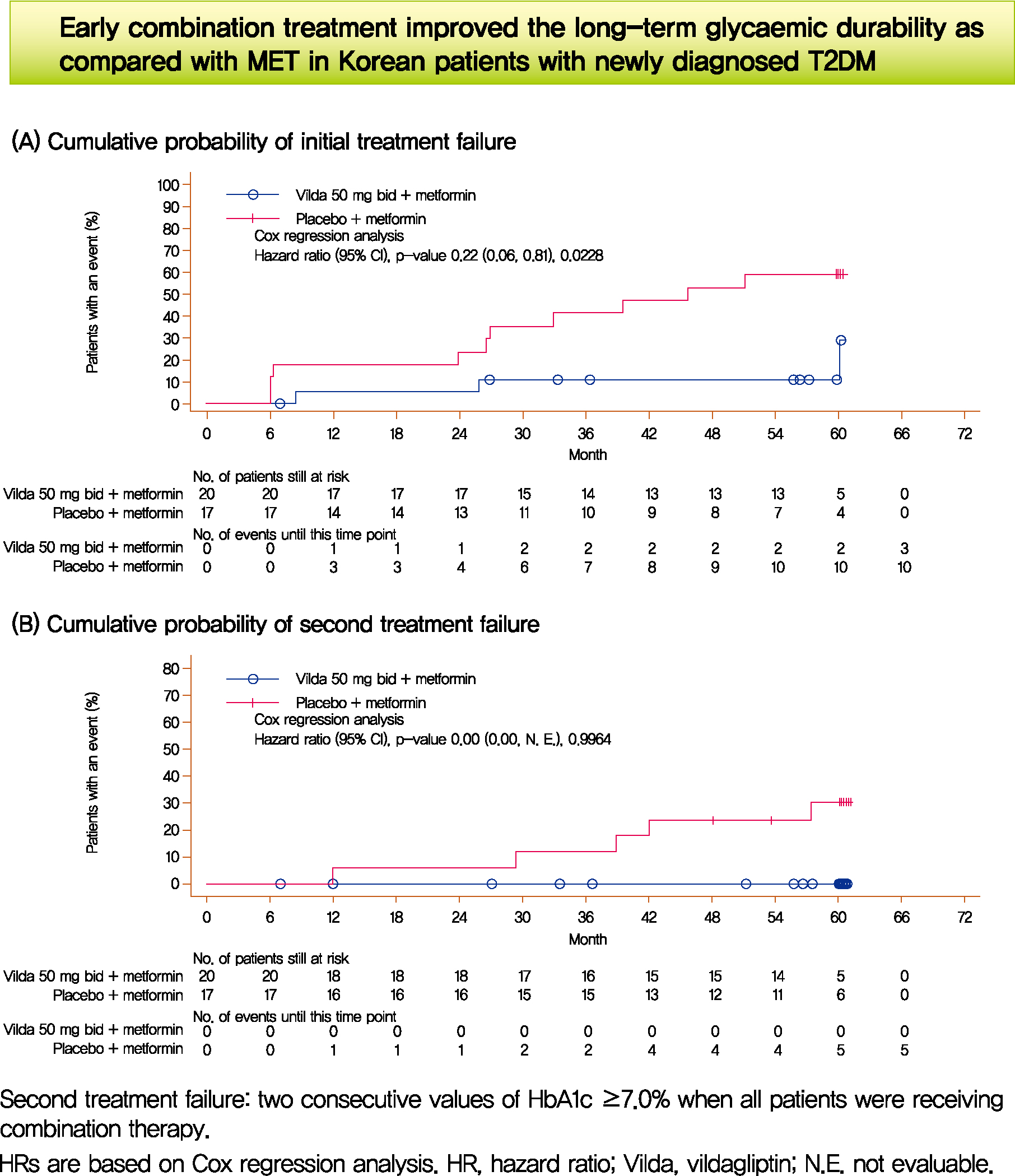
- Current
- Browse
- Collections
-
For contributors
- For Authors
- Instructions to authors
- Article processing charge
- e-submission
- For Reviewers
- Instructions for reviewers
- How to become a reviewer
- Best reviewers
- For Readers
- Readership
- Subscription
- Permission guidelines
- About
- Editorial policy
Search
- Page Path
- HOME > Search
- Drug/Regimen
- Long-Term Glycaemic Durability of Early Combination Therapy Strategy versus Metformin Monotherapy in Korean Patients with Newly Diagnosed Type 2 Diabetes Mellitus
- Soon-Jib Yoo, Sang-Ah Chang, Tae Seo Sohn, Hyuk-Sang Kwon, Jong Min Lee, Sungdae Moon, Pieter Proot, Päivi M Paldánius, Kun Ho Yoon
- Diabetes Metab J. 2021;45(6):954-959. Published online November 12, 2020
- DOI: https://doi.org/10.4093/dmj.2020.0173

- 55,119 View
- 368 Download
- 3 Web of Science
- 2 Crossref
-
 Graphical Abstract
Graphical Abstract
 Abstract
Abstract
 PDF
PDF Supplementary Material
Supplementary Material PubReader
PubReader  ePub
ePub 
- We assessed the glycaemic durability with early combination (EC; vildagliptin+metformin [MET], n=22) versus MET monotherapy (n=17), among newly-diagnosed type 2 diabetes mellitus (T2DM) enrolled (between 2012 and 2014) in the VERIFY study from Korea (n=39). Primary endpoint was time to initial treatment failure (TF) (glycosylated hemoglobin [HbA1c] ≥7.0% at two consecutive scheduled visits after randomization [end of period 1]). Time to second TF was assessed when both groups were receiving and failing on the combination (end of period 2). With EC the risk of initial TF significantly reduced by 78% compared to MET (n=3 [15%] vs. n=10 [58.7%], P=0.0228). No secondary TF occurred in EC group versus five patients (29.4%) in MET. Patients receiving EC treatment achieved consistently lower HbA1c levels. Both treatment approaches were well tolerated with no hypoglycaemic events. In Korean patients with newly diagnosed T2DM, EC treatment significantly and consistently improved the long-term glycaemic durability as compared with MET.
-
Citations
Citations to this article as recorded by- 2023 Clinical Practice Guidelines for Diabetes Mellitus of the Korean Diabetes Association
Jong Han Choi, Kyung Ae Lee, Joon Ho Moon, Suk Chon, Dae Jung Kim, Hyun Jin Kim, Nan Hee Kim, Ji A Seo, Mee Kyoung Kim, Jeong Hyun Lim, YoonJu Song, Ye Seul Yang, Jae Hyeon Kim, You-Bin Lee, Junghyun Noh, Kyu Yeon Hur, Jong Suk Park, Sang Youl Rhee, Hae J
Diabetes & Metabolism Journal.2023; 47(5): 575. CrossRef - 2021 Clinical Practice Guidelines for Diabetes Mellitus of the Korean Diabetes Association
Kyu Yeon Hur, Min Kyong Moon, Jong Suk Park, Soo-Kyung Kim, Seung-Hwan Lee, Jae-Seung Yun, Jong Ha Baek, Junghyun Noh, Byung-Wan Lee, Tae Jung Oh, Suk Chon, Ye Seul Yang, Jang Won Son, Jong Han Choi, Kee Ho Song, Nam Hoon Kim, Sang Yong Kim, Jin Wha Kim,
Diabetes & Metabolism Journal.2021; 45(4): 461. CrossRef
- 2023 Clinical Practice Guidelines for Diabetes Mellitus of the Korean Diabetes Association
- Angiotensin II Inhibits Insulin Binding to Endothelial Cells
- Su-Jin Oh, Won-Chul Ha, Jee-In Lee, Tae-Seo Sohn, Ji-Hyun Kim, Jung-Min Lee, Sang-Ah Chang, Oak-Kee Hong, Hyun-Shik Son
- Diabetes Metab J. 2011;35(3):243-247. Published online June 30, 2011
- DOI: https://doi.org/10.4093/dmj.2011.35.3.243
- 3,843 View
- 24 Download
- 6 Crossref
-
 Abstract
Abstract
 PDF
PDF PubReader
PubReader Background Insulin-mediated glucose uptake in insulin target tissues is correlated with interstitial insulin concentration, rather than plasma insulin concentration. Therefore, insulin delivery to the interstitium of target tissues is very important, and the endothelium may also play an important role in the development of insulin resistance.
Methods After treating bovine aortic endothelial cells with angiotensin II (ATII), we observed the changes in insulin binding capacity and the amounts of insulin receptor (IR) on the cell membranes and in the cytosol.
Results After treatment of 10-7M ATII, insulin binding was decreased progressively, up to 60% at 60 minutes (
P <0.05). ATII receptor blocker (eprosartan) dose dependently improved the insulin binding capacity which was reduced by ATII (P <0.05). At 200 µM, eprosartan fully restored insulin binding capacity, althogh it resulted in only a 20% to 30% restoration at the therapeutic concentration. ATII did not affect the total amount of IR, but it did reduce the amount of IR on the plasma membrane and increased that in the cytosol.Conclusion ATII decreased the insulin binding capacity of the tested cells. ATII did not affect the total amount of IR but did decrease the amount of IR on the plasma membrane. Our data indicate that ATII decreases insulin binding by translocating IR from the plasma membrane to the cytosol. The binding of insulin to IR is important for insulin-induced vasodilation and transendothelial insulin transport. Therefore, ATII may cause insulin resistance through this endothelium-based mechanism.
-
Citations
Citations to this article as recorded by- Acute, local infusion of angiotensin II impairs microvascular and metabolic insulin sensitivity in skeletal muscle
Dino Premilovac, Emily Attrill, Stephen Rattigan, Stephen M Richards, Jeonga Kim, Michelle A Keske
Cardiovascular Research.2019; 115(3): 590. CrossRef - Angiotensin II type 2 receptor inhibits expression and function of insulin receptor in rat renal proximal tubule cells
Yang Yang, Caiyu Chen, Chunjiang Fu, Zaicheng Xu, Cong Lan, Yongchun Zeng, Zhi Chen, Pedro A. Jose, Ye Zhang, Chunyu Zeng
Journal of the American Society of Hypertension.2018; 12(2): 135. CrossRef - Endothelial function, its relation to arterial hypertension and the possibility of its modulation
Vladislav Biel, Jan Novák, Luděk Pluháček, Jiří Špác
Vnitřní lékařství.2018; 64(7-8): 762. CrossRef - Evidence to Consider Angiotensin II Receptor Blockers for the Treatment of Early Alzheimer’s Disease
Juan M. Saavedra
Cellular and Molecular Neurobiology.2016; 36(2): 259. CrossRef - Ameliorative effect of eprosartan on high-fat diet/streptozotocin-induced early diabetic nephropathy in rats
Mohamed A. Morsy, Gehan H. Heeba, Magda E. Mahmoud
European Journal of Pharmacology.2015; 750: 90. CrossRef - Metabolic actions of angiotensin II and insulin: A microvascular endothelial balancing act
Ranganath Muniyappa, Sahzene Yavuz
Molecular and Cellular Endocrinology.2013; 378(1-2): 59. CrossRef
- Acute, local infusion of angiotensin II impairs microvascular and metabolic insulin sensitivity in skeletal muscle

 KDA
KDA
 First
First Prev
Prev





